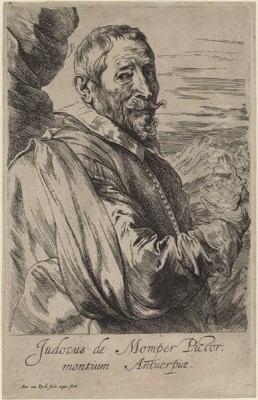
Joos de Momper the Younger stands as one of the most significant and prolific landscape painters of the late 16th and early 17th centuries in Flanders. Active primarily in Antwerp, his career bridged the gap between the Mannerist traditions of the 16th century and the burgeoning Baroque naturalism of the 17th century. His expansive, often fantastical mountain vistas and more intimate, naturalistic scenes defined a particular approach to landscape that proved highly influential, produced within a large and active workshop that dominated the Antwerp market for landscape painting for decades.
An Artistic Heritage
Born in Antwerp in 1564, Joos de Momper (sometimes recorded as Joost or Jodocus) was destined for an artistic career. He hailed from a family already established in the city's art world. His grandfather, Joos de Momper the Elder, had been a painter and art dealer, and his father, Bartolomeus de Momper the Elder, was also a painter, art dealer, printer, and publisher. This familial environment provided Joos the Younger with his initial training, immersing him in the techniques and business of art from an early age. The artistic lineage suggests a continuity of workshop practices and perhaps even stylistic inclinations passed down through generations.
Formal recognition of his training came relatively early. According to the records of the Antwerp Guild of Saint Luke, the city's powerful institution for painters, sculptors, and related craftsmen, Joos de Momper was registered as an apprentice around the age of 17. By 1581, he was accepted as a master ('vrijmeester') in the Guild, a status that allowed him to establish his own workshop, take on apprentices, and sell his works independently. This marked the official beginning of a long and productive career centered in Antwerp, the bustling artistic and commercial hub of the Southern Netherlands.
The Italian Journey and Alpine Visions

Like many Northern European artists of his time, de Momper is believed to have traveled to Italy in the 1580s to further his artistic education and experience the landscapes and art of the south. While direct documentary evidence of his specific itinerary is scarce, the impact of such a journey is strongly reflected in his work. His paintings frequently feature dramatic, towering mountain ranges, craggy peaks, and expansive vistas that strongly evoke the Alps, suggesting he crossed them en route to or from Italy. This journey likely occurred shortly after he became a master in the Guild.
In Italy, he would have encountered the works of both Italian masters and fellow Netherlandish artists working there. Painters like Paul Bril, a Flemish artist active in Rome known for his atmospheric landscapes, and the Verona-based Lodewijk Toeput (known in Italy as Pozzoserrato), another Fleming whose work often featured panoramic views, were contemporaries whose styles might have resonated with de Momper. The experience of the Italian landscape itself, particularly the grandeur of the Alps, seems to have left an indelible mark, becoming a recurring and defining motif in his oeuvre. This fascination with mountainous terrain also connected him to an earlier tradition established by Pieter Bruegel the Elder, whose own Alpine sketches from his Italian journey decades earlier had profoundly influenced Flemish landscape painting.
Bridging Mannerism and Realism: De Momper's Style
Joos de Momper's artistic style is often characterized as transitional. He inherited the Mannerist landscape tradition, particularly the "world landscape" (Weltlandschaft) pioneered by artists like Joachim Patinir and perfected by Pieter Bruegel the Elder. This style typically involved a high viewpoint, offering a panoramic vista encompassing vast distances, often incorporating fantastical rock formations and dramatic contrasts of scale. De Momper adopted this formula, especially in his earlier works, creating sweeping, imaginative scenes that emphasized nature's grandeur and untamed power.
His paintings often employ a conventional Mannerist color scheme to create atmospheric perspective: warm brownish tones dominate the foreground, transitioning to greens in the middle ground, and finally to cool blues and violets in the distant background. This formulaic approach aided in creating a sense of depth and recession in his complex compositions. His brushwork could be broad and energetic, particularly in rendering rocky textures and foliage, contributing to the dynamism of his scenes.
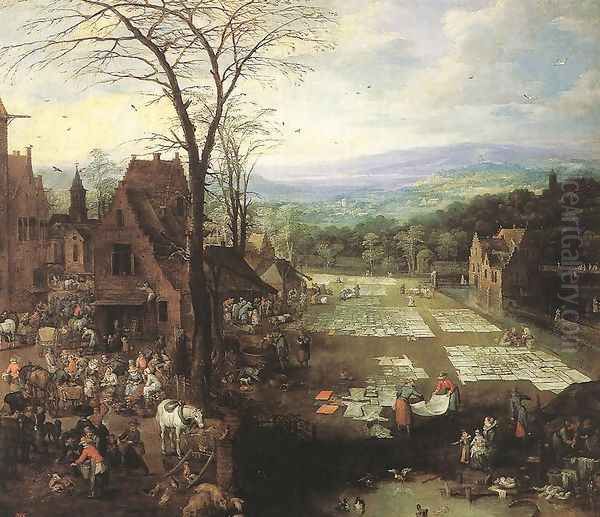
However, de Momper's work also shows a gradual shift towards greater naturalism, reflecting the broader artistic trends of the early 17th century. Alongside his fantastical mountain views, he produced landscapes with lower viewpoints, more specific topographical details, and a greater sensitivity to light and atmosphere. These works, often depicting Flemish countryside, rivers, or villages, anticipate the more realistic landscape painting that would flourish later in the Dutch Golden Age with artists like Jan van Goyen or Jacob van Ruisdael. This duality – the embrace of imaginative, panoramic views alongside more observed, intimate scenes – marks his unique position between two artistic eras.
Themes and Subjects: Mountains, Seasons, and Staffage
The dominant theme throughout de Momper's extensive output is landscape. He excelled particularly in mountain scenes, drawing on his likely Alpine experiences. These are rarely specific, identifiable locations but rather imaginative constructions, emphasizing dramatic cliffs, deep valleys, winding roads, and distant peaks often shrouded in mist. These works convey a sense of awe and wonder before the power of nature, sometimes dwarfing the small human figures often included within them.
Another significant theme was the depiction of the seasons. De Momper produced several series representing Spring, Summer, Autumn, and Winter, often as large-scale decorative cycles. These allowed him to explore different atmospheric conditions, color palettes, and human activities associated with each time of year. His winter landscapes, in particular, are notable for their evocative portrayal of snow-covered terrain, frozen rivers, and bare trees, continuing a tradition popularized by Pieter Bruegel the Elder.
Like most landscape painters of his time, de Momper rarely painted the figures (staffage) in his own landscapes. These small figures, which could be peasants, travelers, soldiers, or biblical and mythological characters, were typically added by specialist figure painters within his workshop or through collaboration with other independent masters. The inclusion of staffage served multiple purposes: it added narrative interest, provided scale, and could elevate a simple landscape into a historical, mythological, or genre scene, making the work more appealing to patrons.
Collaboration and the Workshop
Collaboration was a hallmark of Antwerp painting practice in the 17th century, and Joos de Momper was deeply involved in this system. His large and highly productive workshop likely employed numerous assistants and apprentices who helped produce the vast number of paintings attributed to him or his circle. This workshop model allowed for efficient production but also complicates questions of attribution, with many works likely being collaborative efforts rather than solely by the master's hand.
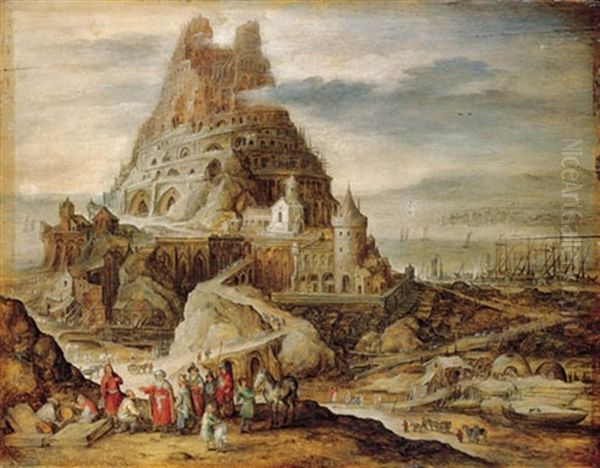
De Momper frequently collaborated with prominent figure painters to add the staffage to his landscapes. His most well-documented and significant collaboration was with Jan Brueghel the Elder and later his son, Jan Brueghel the Younger. Inventories record dozens of paintings created jointly, where Momper provided the expansive landscape settings and the Brueghels added their characteristic, finely detailed figures and animals. These collaborations combined the strengths of both artists, resulting in highly prized works.
Other notable collaborators included Sebastiaen Vrancx, known for his lively battle scenes and genre figures; Hendrik van Balen the Elder, who specialized in elegant mythological and religious figures; and possibly Frans Francken the Younger. Pieter Snayers, a specialist in military scenes, also collaborated with Momper, notably on works like the Allegory of the Senses, commissioned for a significant event in Antwerp. This network of collaboration highlights de Momper's central position within the Antwerp art world.
Representative Works
De Momper's vast oeuvre includes many notable paintings that exemplify his style and themes.
Mountain Landscapes: Numerous works fall into this category, often untitled or generically titled Mountain Landscape with Travelers or Extensive Mountain Landscape. These typically feature the high viewpoint, dramatic rock formations, winding paths, and the characteristic brown-green-blue color progression. Examples can be found in major museums worldwide, including the Prado Museum in Madrid and the Kunsthistorisches Museum in Vienna. A specific example like Mountain Landscape with Cave Dwellers (c. 1610) showcases his imaginative approach to topography and the integration of small figures into a grand natural setting.
The Seasons Series: De Momper painted several sets depicting the four seasons, often large canvases intended for decorative schemes. These works, such as the series in the Herzog Anton Ulrich Museum in Braunschweig, demonstrate his ability to capture the distinct atmosphere and activities of each season, from the blossoming of spring to the harshness of winter. Winter Landscape (c. 1627-1629), whether part of a series or a standalone piece, is a recurring and powerful theme, often featuring snow-covered villages, frozen rivers with skaters, and stark trees against a cold sky, clearly echoing the influence of Pieter Bruegel the Elder's famous Hunters in the Snow.
Flemish Market and Washing Place (c. 1620-1622, Prado Museum): This painting represents de Momper's more naturalistic vein. While still offering a broad view, the setting is recognizably Flemish, depicting everyday life in a village square with market stalls and women washing clothes by a river. The collaboration with Jan Brueghel the Younger is evident in the lively, detailed figures that populate the scene. It shows a move towards genre landscape.
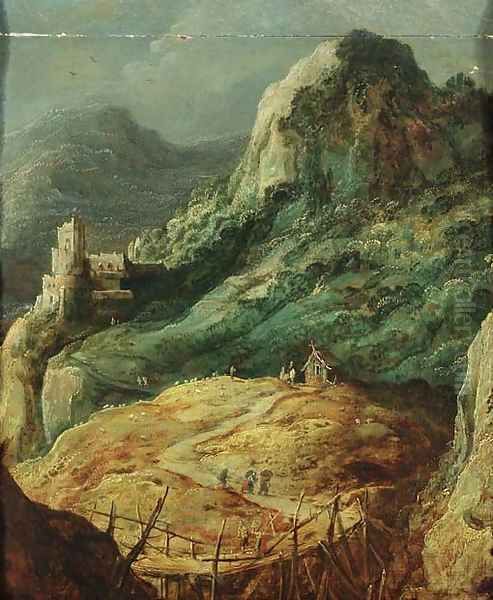
Winter Landscape with the Flight into Egypt: This work combines a biblical narrative with de Momper's favored winter scenery. The Holy Family, likely painted by a collaborator like Jan Brueghel the Elder or Hendrik van Balen, makes its way through a snow-covered, mountainous landscape. The juxtaposition of the sacred story with the detailed rendering of the winter environment is characteristic of Flemish painting of the period.
The Tower of Babel: De Momper painted several versions of this subject, directly engaging with the famous compositions by Pieter Bruegel the Elder. These works allowed him to combine architectural fantasy with his skill in depicting vast landscapes and atmospheric effects, showcasing the immense scale of the mythical tower against an expansive background.
Patronage, Reputation, and Later Life
Joos de Momper enjoyed considerable success and recognition during his lifetime. His workshop was one of the leading producers of landscapes in Antwerp, catering to both local and international markets. He held prestigious positions within the Guild of Saint Luke, serving as its dean in 1611, a testament to his standing among his peers.
He also attracted high-profile patrons. The Archdukes Albert VII and Isabella Clara Eugenia, governors of the Spanish Netherlands, were known patrons of the arts, and evidence suggests they held de Momper in high regard. Archduchess Isabella reportedly granted him exemption from certain taxes and civic duties, a privilege indicating significant favor. While the specific mention of murals for a Spanish governor Adriaen de Estreha in the initial prompt is difficult to verify precisely, patronage from the ruling elite was certainly part of his success. His contemporaries included giants like Peter Paul Rubens, who dominated the Antwerp scene, but de Momper carved out a distinct and highly successful niche in landscape painting.
He married Elisabeth Gobijn in 1590, and the couple had ten children. Following the family tradition, at least one of his sons, Philippe de Momper, also became a painter, likely training and working within his father's workshop. Despite his professional success, however, de Momper seems to have faced financial difficulties later in life. Records indicate that at the time of his death in Antwerp between September 1634 and September 1635 (likely early 1635), he left behind substantial debts. Consequently, many of his assets, including paintings from his collection and workshop stock, had to be sold off by his creditors.
Legacy and Influence
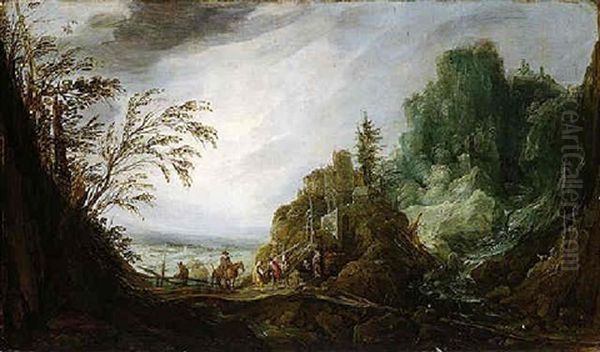
Joos de Momper the Younger left a significant legacy in the history of Flemish art. His workshop produced an enormous number of landscapes that disseminated his style widely. He successfully adapted the 16th-century world landscape tradition for a 17th-century audience, infusing it with both imaginative flair and an increasing degree of naturalistic observation. His mountain landscapes, in particular, remained popular and were emulated by other artists.
He stands as a crucial link between the landscape painting of Pieter Bruegel the Elder and the further developments of the 17th century. While perhaps not as revolutionary as Bruegel or later Dutch masters like Ruisdael, his work represents an important stage in the evolution of landscape as an independent genre. His influence can be seen in the work of his contemporaries and followers in Flanders, and his dramatic mountain scenes may have also resonated with artists like Hercules Seghers in the Dutch Republic.
Today, Joos de Momper's paintings are held in major museum collections across the globe, including the Louvre in Paris, the Prado in Madrid, the Kunsthistorisches Museum in Vienna, the Hermitage Museum in St. Petersburg, and numerous regional museums in Belgium and the Netherlands. They continue to be appreciated for their decorative qualities, their imaginative scope, and their representation of a pivotal moment in the history of European landscape painting. He remains a key figure for understanding the transition from Mannerist fantasy to Baroque naturalism in the Southern Netherlands.
Conclusion
Joos de Momper the Younger was a pivotal figure in Flemish landscape painting, a master whose career spanned the late 16th and early 17th centuries. Born into an artistic family, he rose to prominence in Antwerp, running a large and successful workshop that specialized in landscape views. Influenced by his heritage, a likely journey to Italy, and the towering example of Pieter Bruegel the Elder, he developed a distinctive style characterized by dramatic mountain vistas, panoramic viewpoints, and a conventional yet effective use of color to create depth. His collaborations with renowned figure painters like Jan Brueghel the Elder and Younger enriched his compositions. While rooted in Mannerist traditions, his work also increasingly incorporated naturalistic elements, reflecting the changing artistic currents of his time. Despite facing financial hardship later in life, his prolific output and influential style secured his place as a major master of the Flemish Baroque and a crucial figure in the development of landscape painting as an independent and celebrated genre.